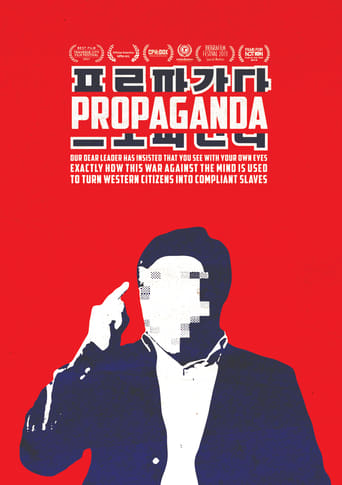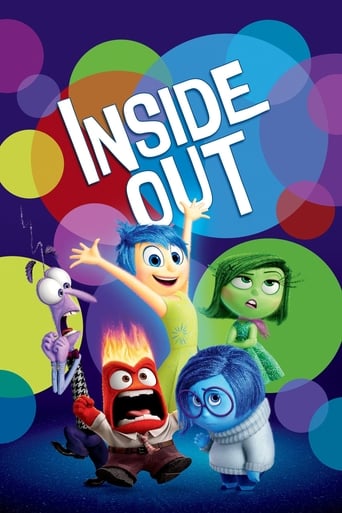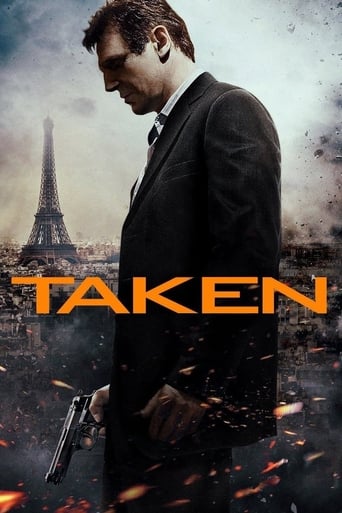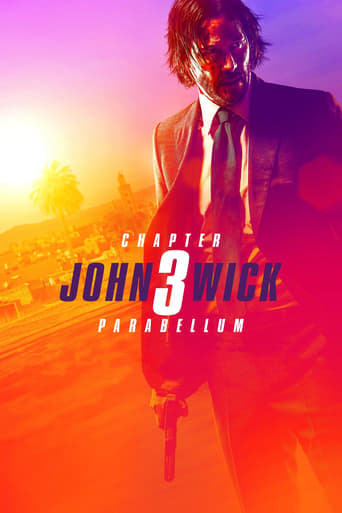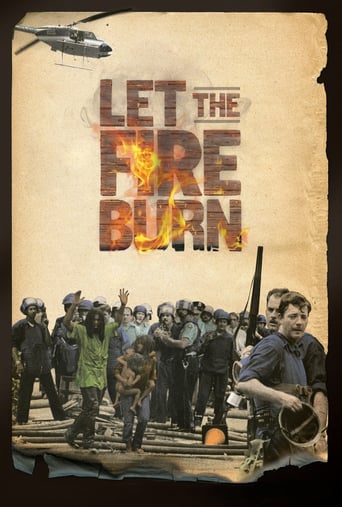


Let the Fire Burn
Jason Osder delivers an account of the incidents leading up to and during the 1985 standoff between the extremist African-American organization MOVE and Philadelphia authorities. The dramatic clash would claim eleven lives and devastate an entire community.
-
- Cast:


Reviews
The Worst Film Ever
From my favorite movies..
It's hard to see any effort in the film. There's no comedy to speak of, no real drama and, worst of all.
what a terribly boring film. I'm sorry but this is absolutely not deserving of best picture and will be forgotten quickly. Entertaining and engaging cinema? No. Nothing performances with flat faces and mistaking silence for subtlety.
This film centers on the relationship of the unorthodox MOVE organization (We are not a cult!) and the city of Philadelphia, both the authorities and neighbors. It uses a community hearing and testimony from one of the child members as the main source plus actual film footage. MOVE supplied re-enactments when needed.The first question posed by the film was are they a cult or an organization? When everyone in the group adopts the surname of the founder and they all proclaim they are following the "strategy of John Africa" what you have is a cult no matter how many times you call it an organization.The second question posed was are they a terrorist group or an organization. I assume they believed everyone would come to the conclusion they were an organization because John Africa claimed they were an organization.The movie had actual recordings of the MOVE organization shouting f-bombs and MF-bombs through a megaphone into a residential area street where children play. Can't say I would want them as a neighbor. The fact that it took the city to burn down their house before the neighbors did turned out to be the biggest mystery of the film.Rule of thumb: When the government shows up at your door heavily armed (or with a tank like Waco) that is not the time to decide you are within your right to stay put, whether you are or not. You can make your argument later, file a civil rights suit etc. Now if you believe you can't win in court because the system is stacked against you, and you would rather take your odds against a tank, go ahead be my guest because you really don't belong in the gene pool anyway.I had sympathized with the MOVE organization believing they were a quiet peaceful counter culture group, but the film demonstrated they were simply masquerading.Was is a tragedy? Yes. Could the city of Philadelphia handled it better? Yes. But MOVE refused to obey lawful orders and as such must also bare some responsibility for the tragedy, which the film seems to want to ignore.Parental Guide: F-bombs, MF bombs and naked children courtesy of MOVE.
Let the Fire Burn, Director Jason Osder's first feature film, chronicles the chaotic and destructive events between the Philadelphia Police Department and the radical group MOVE from the 1970's to the 1980's. Contrary to most Documentary films, Osder uses no interviews, no re-enactments and no un-needed footage. Instead, Osder employs his own style by using only archival footage, showing the film in a sort of "real time". The footage is not shown in chronological order, instead he edits the clips in an order to show the lies and deceit behind the claims of most of the police officers. MOVE, the radical group the film's focus is on, is a black liberation group that frequently engage in demonstrations against racism and police brutality. The group was founded in 1972, and this is where Osder's film begins. It chronicles MOVE's rise as a group in the early 1970's, it's conflicts with the police, and the escalation of violence between the two groups. Osder doesn't show this one after the other like a timeline. Instead, he edits the clips into different parts of the film to provide pacing and to clearly state the message he is trying to share. Through depositional interviews and an archived documentary, Osder provides context on the MOVE organization for the audience. He then goes back and forth between differing footage as the events between MOVE and the police begin to escalate. As tensions begin to elevate, such as a police officer getting shot and killed, Osder still keeps the focus on the actions of the police and the in- justice that accompanies the MOVE organization. Even though a police officer was killed, juxtaposing footage doesn't prove that a MOVE member killed the officer. Other footage then shows the beating of a defenseless black man, Delbert Africa. While this footage is played, testimony from the police is played over, showing that the footage doesn't match the statements made by police. Officers suggested that Delbert Africa had a knife and was acting violently, when the footage shows that he walked out of the house with his hands held high, no weapons on him, completely defenseless. Not to mention that eventually 9 people would be found guilty for the murder of one person, and all 9 people were sentenced to life in jail. And yes, you did in fact read that right. Osder does this many times throughout the film, juxtaposing the archival footage he has with the live testimony from the officers present. Each time, the footage overrules the statements made, revealing the distortion and fabrication. While the film itself focuses on a terrible issue, it struck me that this even occurred over 30 years ago, yet is still relevant to America today. Police are still not held accountable for their actions, they are still treated above the law. Because it is still relevant today, it makes the film that much better. That people can still be showed this film, and it can still make them think and discuss the issues that face this country. Finally, the last part of the film I want to touch on is actually a person, Birdie Africa. He was the only child to survive the tragedy, and he is the real message of the film. 5 children inevitably died, and the first-hand account that Birdie shares is truly frightening. Children were burned alive while firefighters and officers stood outside and watched, and did nothing. It infuriates me to even think about it while writing this, but 11 people died and no one was charged. 1 officer dies, and nine people are charged for that one death. Osder is trying to point out the huge discrepancies between police and everyone else, to bring attention to a tragedy still relevant today, to discuss the gross injustice that still lives. This film was great but it was not enjoyable, because it showed me the truth, and sometimes the truth can be uglier than you could possibly imagine.
Let the Fire Burn is a documentary about an almost forgotten series of incidents that were in many ways like the later Waco fiasco. Sadly, it seems that government officials hadn't learned from this earlier experience in Philadelphia.Back in the 1970s, an odd group was created in Philadelphia that called itself 'MOVE'. They were rather cult-like by outward appearances and their members lived communally. They apparently raised their children naked and fed them raw foods—insisting on a back to nature approach to life. Their exact beliefs and practices were a bit vague when I watched Let the Fire Burn, but the organization fell afoul of society for two obvious reasons—they lived within a large city and could not go unnoticed living this way and they were also very anti-police. Whether they became anti-police as a result of police persecution or they began that way is difficult to know based on what I saw in the film. Regardless, they and the police disliked and distrusted each other.After years of antagonism and some incidents of violence, MOVE set up headquarters in a neighborhood row house and appeared to be trying to provoke some sort of action or compromise. They began blasting messaged laced with profanities on loudspeakers and built some bunkers on the roof of this row house to resist the police. Naturally the neighbors hated this and wanted some action—and it couldn't remain that way for long. However, the degree to which the police responded took people by surprise. They surrounded the place and pumped thousands of bullets into the row house. Then, after some time passed, they had a helicopter fly over and drop a large bomb on the place. After the explosion, the police and fire departments did nothing—they just let the fire burn— claiming it was too dangerous to allow fire crews near the blaze. Not surprisingly, most of the people inside were killed and about half of them were children. Because the fires were not put out, pretty much the whole neighborhood ending up being gutted. According to the film, the cheap housing put up to replace these homes was later condemned. Obviously this was NOT Philadelphia's finest hour!As a retired history teacher, my thought is always on what we can learn from the incident. As I mentioned above, about a decade later the federal government had a somewhat similar situation with the Branch Davidian cult in Waco, Texas. Claiming to be concerned about child abuse, the rescue mission ended up killing everyone inside this complex! Obviously, we did not learn from the MOVE tragedy.But what other lessons can we learn from the firebombing in Philadelphia? The filmmakers really don't take an obvious opinion, as there is no narration—just archival footage. The film leaves many, many questions unanswered. It's inferred that the filmmakers felt the police overreacted and mentioned that later civil cases awarded damages to the survivors—but beyond that, it's difficult to say. What might have made this much clearer would have been to include new interviews in order to see how the participants and survivors see the incident today. This is problematic, however, as the lone teen survivor recently drowned on a cruise ship. As for the other survivor, Ramona Africa (who also survived and was jailed following the incident), the film indicated that she is alive and fighting the system BUT didn't have any recent interviews with her. Additionally, while some archival footage was shown of a couple MOVE members who were not in the home during the firebombing, oddly they were not interviewed either by the filmmakers. Even then, SOME of the police, news reporters and government officials could have been interviewed. Because it lacks any sort of attempt to try to make sense of all this almost 30 years later, the film loses a bit of its punch. However, it still packs quite a strong emotional appeal without this and is very well made. It leaves the viewer numb and, in my case, vaguely angry that the situation was handled in such a heavy- handed fashion.
Growing up on the East Coast near Philadelphia, I became used to the local news reports of the latest problems with a group call MOVE – a "back to nature", almost survivalist group. What I knew about them came from those local newscasts, which were usually about a police confrontation of one sort or another. What also stood out about them to me was that all the members had the last name of "Africa", and that they occupied a townhouse smack dab in the middle of a blue collar, working class neighborhood. When one thought of communes at the time, one thought of encampments out in a remote forest. Well this commune shared walls with working class homes and families, and their rejection of technology led to no electricity, boarded up windows, and mounds of trash on the sidewalks. I left the area in 1982 and headed for California.Imagine my surprise three years later to turn on CNN and find them covering the mass destruction of an entire city block in Philadelphia, and that MOVE was at the center of the inferno. After a failed attempt at eviction and after shots had been fired, the decision was made to drop an incendiary device on the roof of the house to destroy a fortified bunker. Things quickly got out hand. The result – eleven people dead, including five children, and 60 other homes burned to the ground. How did this happen? Filmmaker Jason Osder's "Let the Fire Burn" uses archival news footage, depositions and the filmed record of an investigative commission to retell the story of the MOVE clash. Big news at the time, but mostly forgotten today (overshadowed, no doubt by the Waco/Branch Davidian siege) Osder recaptures the feel and mood of the time and allows the protagonists to speak for themselves. His film is not a polemic on government abuse or the evils of racism (the mayor of Philadelphia at the time and the majority of the citizens affected were African-American). "Let the Fire Burn" is simply the filmed record of an event, masterfully edited in a way that, while knowing full well what the outcome is going to be, keeps you engrossed from start to painful finish.At a time when civility seems to be rapidly diminishing in what passes for political discourse these days, it is good to be reminded of what the real result of extreme action, of any kind or on any side, can be. Just ask the residents of Osage Avenue in West Philadelphia.www.worstshowontheweb.com


